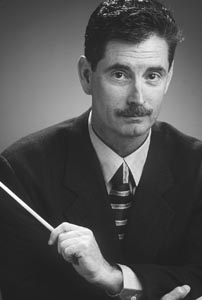![[MetroActive Music]](/gifs/music468.gif)
[ Music Index | Santa Cruz | MetroActive Central | Archives ]
Discipline and Abandon
John Larry Granger takes big risks with program choices at County Symphony
By Scott MacClelland
IF ONE COMPONENT of an artistic performance is risk, John Larry Granger ended his current Santa Cruz County Symphony season with some fearless adventuring. Between March's performance of Stravinsky's Le Sacre du Printemps and last weekend's reading of Mahler's Symphony no. 2 (Resurrection), Granger took himself and his orchestra out on a limb.
Rarely do works of such challenges appear on regional orchestra programs. (Granger has himself backed away from such formidable projects in his 20002001 season, to the safer ground of Beethoven, Mendelssohn, Dvorák, et al.) But these two works raised plenty of questions and produced some surprising answers. Among the latter were two of the largest audiences ever to attend the Santa Cruz Symphony. Leading the former would have to be: What's Granger up to?
Obviously, the man is hell-bent on enlarging his repertoire. With few exceptions in recent seasons, he has memorized nearly every score. He now conducts with a razor-edge technique that leaves virtually no doubt as to his intentions. Articulate in speaking to audiences, he has the reputation among musicians for a sharply impatient tongue.
For better or worse, Granger finds himself at a potentially vulnerable stage in his career. (He expressed to me dismay at how the Fresno Philharmonic music director was sacked, in spite of exceptional musicianship.) When orchestras search for music directors these days, they tend to favor young firebrands, women and musicians of color and/or foreign-born.
These days, white men in their 40s and 50s have to demonstrate unusual ambition, salesmanship and/or political savvy if they expect to make the final cut. (In fact, Granger's immediate future is secure, having won contract extensions from both the symphony and his youth orchestra programs with Youth Music Monterey.)
IN THE MEANTIME, Granger has obviously been fired up in tackling the Stravinsky and the Mahler. We are now seeing the work of an intensely driven musician, a man determined to prevail no matter the difficulties, to become a complete master of his craft.
What remains to be gauged is the artistic consequence of this renewed zeal. But clearly, Granger is on the right track. Indeed, he has no choice if he is to be recognized as a podium artist, a reputation few conductors ever achieve.
Mahler demands more interpretive personality than most composers. While this reading lacked intensity and sentiment in its intimate moments, there was plenty of compensation by the force of Granger's assertive leadership.
It must be noted, with respect to both the Stravinsky and the Mahler, that the Santa Cruz Civic Auditorium murders acoustic resonance, particularly of large orchestras deployed on the flat floor.
Just under 100 musicians participated in this production, many getting exposed solo opportunities. They were joined by Cheryl Anderson's Cabrillo Symphonic Choir and soprano soloists Julia Kierstine and Tonya Currier, a vocal complement that acquitted itself with distinction.
The long first movement was followed by a short break during which the orchestra could have retuned. Instead, the strings began the second movement out of tune and were given virtually no chance after that to do more than compensate for the problem.
The brass and winds were able to sustain tone, but the giant percussion strokes were helpless against the acoustic drought. Instant decay reduced them from awesome thunder to brittle whacks.
Mahler's Resurrection is a strange work, formally stretched and distorted according to a background program that the composer chose to suppress after the fact. Curiously, it has something of a cult following, groupies who care nothing about Mahler's other works, even while it plainly fits right in with the overall lineage of his musical journey. Having survived this gauntlet-run, Larry Granger now gets to figure out how to achieve more discipline and more abandon at the same time.
[ Santa Cruz | MetroActive Central | Archives ]
Copyright © Metro Publishing Inc. Maintained by Boulevards New Media.
![]()

Life in the Fast Lane: Symphony conductor John Larry Granger showed increasing drive at concerts featuring monumental works.
From the May 10-17, 2000 issue of Metro Santa Cruz.